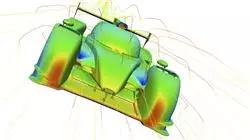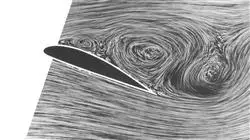University certificate
The world's largest faculty of information technology”
Introduction to the Program
Become an expert in Turbulence and boundary layer Techniques, thanks to the best online university in the world according to Forbes, thanks to TECH Global University"

Turbulence and boundary layer modeling is an essential tool for the simulation and design of systems that engage fluid dynamics. For computer scientists, their study and knowledge is essential for the development of more accurate and efficient algorithms and simulation software. In addition, they have applications in a wide range of fields, demonstrating their relevance.
For this reason, TECH has designed a Postgraduate certificate in Turbulence Modeling and Boundary Layer to provide students with the necessary skills and competencies to be able to perform their work as specialists with the highest possible efficiency and quality. Thus, throughout this program, aspects such as RANS Methods, LES evolution, Wall I Turbulence or Fanno and Rayleigh Flows will be addressed.
All this, through a convenient 100% online modality that allows Students to organize their schedules and studies, combining them with their other work and interests. In addition, this degree has the most Complete theoretical and practical materials on the market, which facilitates the student's study process and allows them to achieve their objectives quickly and effectively.
Reach your maximum potential in this field, delving into topics such as RANS Equations and Spectral Filters, in only 6 weeks and with total freedom of organization"
This Postgraduate certificate in Turbulence Modeling and Boundary Layer contains the most complete and up-to-date program on the market. The most important features include:
- The development of practical cases presented by experts in Turbulence Modeling and Boundary Layer
- The graphic, schematic and practical contents of the program provide Rehabilitation and practical information on those disciplines that are essential for professional practice
- Practical exercises where self-assessment can be used to improve learning
- Its special emphasis on innovative methodologies
- Theoretical lessons, questions to the expert, debate forums on controversial topics, and individual reflection assignments
- Content that is accessible from any fixed or portable device with an Internet connection
Improve your professional profile in one of the most promising areas of the IT sector, thanks to TECH Global University and the most innovative materials"
The program’s teaching staff includes professionals from the sector who contribute their work experience to this training program, as well as renowned specialists from leading societies and prestigious universities.
Its multimedia content, developed with the latest educational technology, will allow the professional a situated and contextual learning, that is, a simulated environment that will provide an immersive training programmed to train in real situations.
The design of this program focuses on Problem-Based Learning, in which the professional will have to try to solve the different professional practice situations that will arise throughout the academic course. For this purpose, the student will be assisted by an innovative interactive video system created by renowned experts.
Enroll now and enjoy all the content on Characteristic Scales and Turbulent Viscosity Hypothesis, from your Tablet, mobile or computer"

Deepen your knowledge of Spectral Methods and Visualization Techniques from the comfort of your home and at any time of the day"
Why study at TECH?
TECH is the world’s largest online university. With an impressive catalog of more than 14,000 university programs available in 11 languages, it is positioned as a leader in employability, with a 99% job placement rate. In addition, it relies on an enormous faculty of more than 6,000 professors of the highest international renown.

Study at the world's largest online university and guarantee your professional success. The future starts at TECH”
The world’s best online university according to FORBES
The prestigious Forbes magazine, specialized in business and finance, has highlighted TECH as “the world's best online university” This is what they have recently stated in an article in their digital edition in which they echo the success story of this institution, “thanks to the academic offer it provides, the selection of its teaching staff, and an innovative learning method aimed at educating the professionals of the future”
A revolutionary study method, a cutting-edge faculty and a practical focus: the key to TECH's success.
The most complete study plans on the university scene
TECH offers the most complete study plans on the university scene, with syllabuses that cover fundamental concepts and, at the same time, the main scientific advances in their specific scientific areas. In addition, these programs are continuously being updated to guarantee students the academic vanguard and the most in-demand professional skills. In this way, the university's qualifications provide its graduates with a significant advantage to propel their careers to success.
TECH offers the most comprehensive and intensive study plans on the current university scene.
A world-class teaching staff
TECH's teaching staff is made up of more than 6,000 professors with the highest international recognition. Professors, researchers and top executives of multinational companies, including Isaiah Covington, performance coach of the Boston Celtics; Magda Romanska, principal investigator at Harvard MetaLAB; Ignacio Wistumba, chairman of the department of translational molecular pathology at MD Anderson Cancer Center; and D.W. Pine, creative director of TIME magazine, among others.
Internationally renowned experts, specialized in different branches of Health, Technology, Communication and Business, form part of the TECH faculty.
A unique learning method
TECH is the first university to use Relearning in all its programs. It is the best online learning methodology, accredited with international teaching quality certifications, provided by prestigious educational agencies. In addition, this disruptive educational model is complemented with the “Case Method”, thereby setting up a unique online teaching strategy. Innovative teaching resources are also implemented, including detailed videos, infographics and interactive summaries.
TECH combines Relearning and the Case Method in all its university programs to guarantee excellent theoretical and practical learning, studying whenever and wherever you want.
The world's largest online university
TECH is the world’s largest online university. We are the largest educational institution, with the best and widest online educational catalog, one hundred percent online and covering the vast majority of areas of knowledge. We offer a large selection of our own degrees and accredited online undergraduate and postgraduate degrees. In total, more than 14,000 university degrees, in eleven different languages, make us the largest educational largest in the world.
TECH has the world's most extensive catalog of academic and official programs, available in more than 11 languages.
Google Premier Partner
The American technology giant has awarded TECH the Google Google Premier Partner badge. This award, which is only available to 3% of the world's companies, highlights the efficient, flexible and tailored experience that this university provides to students. The recognition as a Google Premier Partner not only accredits the maximum rigor, performance and investment in TECH's digital infrastructures, but also places this university as one of the world's leading technology companies.
Google has positioned TECH in the top 3% of the world's most important technology companies by awarding it its Google Premier Partner badge.
The official online university of the NBA
TECH is the official online university of the NBA. Thanks to our agreement with the biggest league in basketball, we offer our students exclusive university programs, as well as a wide variety of educational resources focused on the business of the league and other areas of the sports industry. Each program is made up of a uniquely designed syllabus and features exceptional guest hosts: professionals with a distinguished sports background who will offer their expertise on the most relevant topics.
TECH has been selected by the NBA, the world's top basketball league, as its official online university.
The top-rated university by its students
Students have positioned TECH as the world's top-rated university on the main review websites, with a highest rating of 4.9 out of 5, obtained from more than 1,000 reviews. These results consolidate TECH as the benchmark university institution at an international level, reflecting the excellence and positive impact of its educational model.” reflecting the excellence and positive impact of its educational model.”
TECH is the world’s top-rated university by its students.
Leaders in employability
TECH has managed to become the leading university in employability. 99% of its students obtain jobs in the academic field they have studied, within one year of completing any of the university's programs. A similar number achieve immediate career enhancement. All this thanks to a study methodology that bases its effectiveness on the acquisition of practical skills, which are absolutely necessary for professional development.
99% of TECH graduates find a job within a year of completing their studies.
Postgraduate Certificate in Turbulence and Boundary Layer Modeling.
Turbulence is a characteristic of flow in which twists and eddies are present, forming spirals and vortices. This type of flow is due to the complex and nonlinear interaction between the motion of the same fluid mass at different locations and at different scales, which can result in energy dissipation and unexpected temperature rise. On the other hand, the boundary layer refers to the zone adjacent to the solid surface where the fluid undergoes a transition to a more stable flow. As the fluid moves within the boundary layer, an increase in velocity (velocity gradient) occurs. This gradient produces a friction layer, which slows down the fluid motion. At TECH Global University we have this specialized program designed to provide practical theoretical knowledge on to understand and predict the behavior of turbulent flows around objects and solid surfaces.
Turbulent flow simulation is a very useful tool to understand and predict the behavior of turbulent flows around objects and solid surfaces.
Turbulence and boundary layer simulation is a very important technique in the aeronautical, military, transportation and energy industries, to name a few examples. The development of this simulation involves modeling the flow equations, numerical solution with CFD software, and interpretation of the results to verify that the model and results are reasonable and accurately represent the actual conditions of the problem. In our Postgraduate Certificate you will address the concepts on fluid simulation techniques to model and analyze turbulent behavior and boundary layer in different systems and applications.







